Dell 2407WFP and 3007WFP LCD Comparison
by Jarred Walton on March 2, 2007 11:30 AM EST- Posted in
- Displays
Dell 2407WFP: Appearance and Design
The 2407WFP has the typical look of a Dell LCD: a relatively narrow black bezel with silver trim. Opinions as to what looks best are going to vary, but we are generally pleased with the appearance of the Dell displays. Users interested in running multi-display configurations might want an even narrower bezel, but at roughly one inch wide it becomes difficult for manufacturers to trim much more off the width.
Like most LCDs, the 2407WFP comes with a base stand that allows you to raise, lower, tilt, and swivel the main panel. Vertical travel is a reasonable four inches, which should be enough for most people. Tilting the display will also raise the LCD several more inches.
You can rotate the display into portrait mode, although here the stand doesn't allow enough vertical travel so you have to tilt the display before rotating it. How many people are really interested in using widescreen displays in portrait mode is debatable, but at the very least it does make the process of connecting any cables much easier, since you can get a clear view of the bottom of the LCD.
All of the input ports are located on the back of the panel, facing downward. (That's why the ability to rotate the display is convenient.) As mentioned on the previous page, the 2407WFP allows up to five inputs to be used, and you can switch between inputs via the On-Screen Display (OSD).
Besides the five potential video inputs, the back of the display also comes with a USB input that allows the display to function as a USB hub. There's also a power connection for an optional speaker bar that can be attached to the bottom of the display. There are two USB ports on the rear of the panel and two more on the left side. The left side is also home to a flash memory reader that accepts most of the common formats: CompactFlash, Secure Digital, Sony Memory Stick (1, 2, and Pro), SmartMedia, and Multimedia Card; the only major format that isn't supported is xD. If you frequently find yourself using USB cables to connect your computer to a digital camera, the integrated flash memory reader is extremely convenient. Read and write performance appears to be limited by the capabilities of your flash memory.
At the bottom of the display are five buttons used to control the OSD. The far left button is a shortcut allowing you to quickly switch between video inputs, while the second button is used to toggle the Picture-in-Picture (PIP) functions. The remaining three buttons are used to access the main OSD menu and select/adjust the various options. Here's a quick look at the major functions present in the OSD.
Most of the features we like to see in an OSD are available, but if you use a digital connection some of these options are disabled. For example, screen scaling defaults to fill/stretch when using a DVI connection, and you need to use your graphics card drivers to change the scaling options. This was not the case on the older Dell 2405FPW, and frankly we preferred the ability to control this function directly from the display rather than resorting to drivers. Not all drivers have all of the necessary options, and if you run an alternative OS it is even less likely to have full control over the display scaling.
Editor's Note: The LCD we have for review is revision A01 (possibly refurbished at some point). It appears revision A04 now supports setting the scaling on DVI connections. Unfortunately, there doesn't appear to be any way to guarantee that the Dell LCD you purchase will be revision A04.
Analog connections also enable the menu items for sharpness and zoom. Contrast is locked at a set value, but you can control the brightness of the lamp and you can also adjust color options. The Image Modes menu provides three settings that can be used for various tasks, so it is possible to have three custom configurations for gaming, multimedia, and business use.
As a package, the 24" Dell LCDs have always been a popular choice among display enthusiasts, and it's easy to see why. The more recent 2407WFP improves upon the older model in several areas, chief among these being the addition of HDCP support. We also like the change in the base stand, which allows the 2407WFP to sit very close to the level of your desk. If you already have a 2405FPW, there's not necessarily a big reason to upgrade, but given the choice between the two we definitely prefer the new model. Prices have also become a lot more attractive overtime, with the 2407WFP currently selling for $675 -- compare that to the launch price of the 2405FPW, which was originally more than twice that.
The 2407WFP has the typical look of a Dell LCD: a relatively narrow black bezel with silver trim. Opinions as to what looks best are going to vary, but we are generally pleased with the appearance of the Dell displays. Users interested in running multi-display configurations might want an even narrower bezel, but at roughly one inch wide it becomes difficult for manufacturers to trim much more off the width.
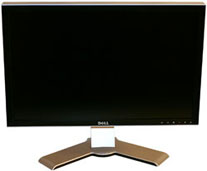 |
 |
| Click to enlarge | |
Like most LCDs, the 2407WFP comes with a base stand that allows you to raise, lower, tilt, and swivel the main panel. Vertical travel is a reasonable four inches, which should be enough for most people. Tilting the display will also raise the LCD several more inches.
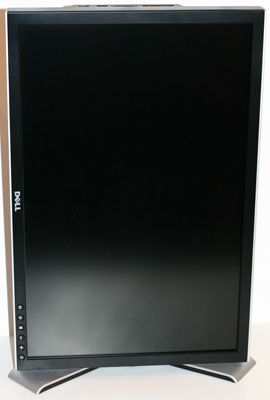 |
| Click to enlarge |
You can rotate the display into portrait mode, although here the stand doesn't allow enough vertical travel so you have to tilt the display before rotating it. How many people are really interested in using widescreen displays in portrait mode is debatable, but at the very least it does make the process of connecting any cables much easier, since you can get a clear view of the bottom of the LCD.
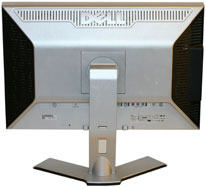 |
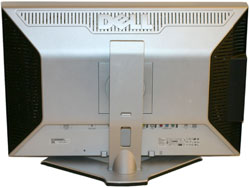 |
| Click to enlarge | |
All of the input ports are located on the back of the panel, facing downward. (That's why the ability to rotate the display is convenient.) As mentioned on the previous page, the 2407WFP allows up to five inputs to be used, and you can switch between inputs via the On-Screen Display (OSD).
 |
 |
| Click to enlarge |
Besides the five potential video inputs, the back of the display also comes with a USB input that allows the display to function as a USB hub. There's also a power connection for an optional speaker bar that can be attached to the bottom of the display. There are two USB ports on the rear of the panel and two more on the left side. The left side is also home to a flash memory reader that accepts most of the common formats: CompactFlash, Secure Digital, Sony Memory Stick (1, 2, and Pro), SmartMedia, and Multimedia Card; the only major format that isn't supported is xD. If you frequently find yourself using USB cables to connect your computer to a digital camera, the integrated flash memory reader is extremely convenient. Read and write performance appears to be limited by the capabilities of your flash memory.
At the bottom of the display are five buttons used to control the OSD. The far left button is a shortcut allowing you to quickly switch between video inputs, while the second button is used to toggle the Picture-in-Picture (PIP) functions. The remaining three buttons are used to access the main OSD menu and select/adjust the various options. Here's a quick look at the major functions present in the OSD.
 |
 |
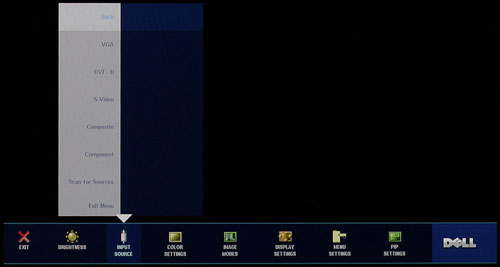 |
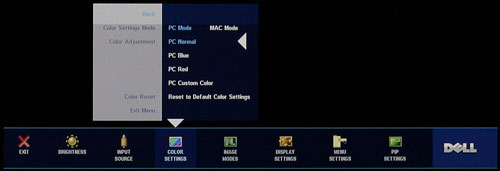 |
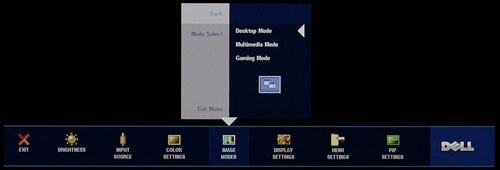 |
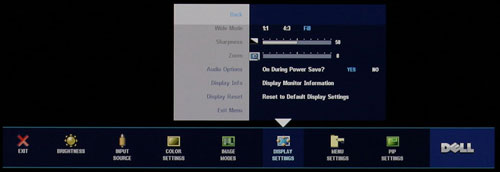 |
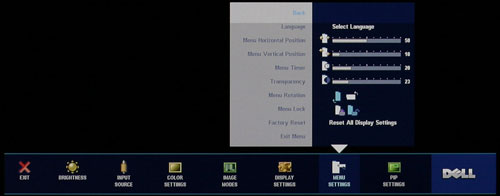 |
 |
| Click to enlarge |
Most of the features we like to see in an OSD are available, but if you use a digital connection some of these options are disabled. For example, screen scaling defaults to fill/stretch when using a DVI connection, and you need to use your graphics card drivers to change the scaling options. This was not the case on the older Dell 2405FPW, and frankly we preferred the ability to control this function directly from the display rather than resorting to drivers. Not all drivers have all of the necessary options, and if you run an alternative OS it is even less likely to have full control over the display scaling.
Editor's Note: The LCD we have for review is revision A01 (possibly refurbished at some point). It appears revision A04 now supports setting the scaling on DVI connections. Unfortunately, there doesn't appear to be any way to guarantee that the Dell LCD you purchase will be revision A04.
Analog connections also enable the menu items for sharpness and zoom. Contrast is locked at a set value, but you can control the brightness of the lamp and you can also adjust color options. The Image Modes menu provides three settings that can be used for various tasks, so it is possible to have three custom configurations for gaming, multimedia, and business use.
As a package, the 24" Dell LCDs have always been a popular choice among display enthusiasts, and it's easy to see why. The more recent 2407WFP improves upon the older model in several areas, chief among these being the addition of HDCP support. We also like the change in the base stand, which allows the 2407WFP to sit very close to the level of your desk. If you already have a 2405FPW, there's not necessarily a big reason to upgrade, but given the choice between the two we definitely prefer the new model. Prices have also become a lot more attractive overtime, with the 2407WFP currently selling for $675 -- compare that to the launch price of the 2405FPW, which was originally more than twice that.










62 Comments
View All Comments
Zebo - Friday, March 2, 2007 - link
The HC is still IPS and even better this time covering 93% of adobe color gamet vs 72% past model and it's more overdriven making it faster. Inputs are still lame with DVI only.Right now only corp customers can get the HC.
There is a non technical review floating around the net with nice pics..hot hardware I think.
acivick - Friday, March 2, 2007 - link
As nice as these monitors are, it seems to be that no one is really releasing any new 4:3 or 5:4 monitors anymore. Everything is widescreen. Sure, I think it's great when you're watching movies, but that's why I have a widescreen TV.I primarily use my PC for office work and games, neither of which really lend themselves to widescreen very well. Maybe a lot of newer games are coming out with widescreen support, but a good number don't offer it, at least officially.
Maybe I'm just a minority now, since every company seems to be focusing on it. Anyone else with similar opinions?
JarredWalton - Friday, March 2, 2007 - link
I definitely prefer WS displays, even outside of gaming. The ability to easily put two full pages of text next to each other is nice, and it's one of the reasons I don't find portrait mode on larger WS LCDs to be useful. I just wish more games were properly (i.e. natively with proper aspect ratio) supporting widescreen modes. On smaller displays, however, I'm not as big a fan of WS - I'd prefer a 19/20" standard AR over a 19/20" WS display. Basically, if you can't get at least 1680x1050 I'd just as soon stick with a normal AR.yyrkoon - Friday, March 2, 2007 - link
Personally, I think it would be good to include power usage of LCD monitors you're testing. I know you guys have the equipment already, and this is one of a few reasons why people use LCD vs CRT. Is this information in the article aready ? IF so, I missed it . . .mongo lloyd - Saturday, March 3, 2007 - link
Lower power consumption with LCDs is mostly a myth nowadays when you're moving up to the bigger and/or brighter monitors. As you can see with the specs here, both these monitors eat as much as (in the case of the 24") and more power than (in the case of the 30") a 21-22" CRT (most commonly ~125 W). The few business-oriented CRTs that are still available usually draw around 75-85 W, which many LCDs do as well.So that "benefit with LCD monitors" is also questionable...
JarredWalton - Friday, March 2, 2007 - link
It's listed on the specs tables, although those are manufacturer figures. They're generally accurate, however, with a pure white output using more power than a black output. I'll see about adding a quick test of min/max/avg power use on future reviews, though - thanks for the suggestion.tmok2007 - Friday, March 2, 2007 - link
Sorry, the 3007WFP is selling for $1,350. Where can I find a 37" or 42" 1080p LCD TV for less than this?timmiser - Friday, March 2, 2007 - link
The Westinghouse 37" model is available at Newegg for $999.JarredWalton - Friday, March 2, 2007 - link
Check Google/Froogle: Westinghouse makes a 1080p 42" that starts at around $1300, and the 37" is slightly less IIRC.exdeath - Friday, March 2, 2007 - link
Could we add the 2707WFP in there?Its a 27" compromise between the wider range of capabilities of the 30" and the smaller size of the 24"
Single link 1920x1200 with a built in scaler (and thus multiple inputs) but larger than the 24". 1920x1200 is also more manageable for gaming, as even with 8800 SLI some games just can't run fast and smooth enough at 2560x1600.
As for the .303mm pixel pitch, keep in mind that a 19" 4:3 1280x1024 screen that I would wager is the most common LCD in use right now is like .295mm and I never heard anyone complaining about the 19" displays... I think breaking the .3xx barrier is more of a psychological effect of seeing a "3" in the dot pitch spec more than anyone being truly disturbed by perceived graininess. Also, the 37" and 42" screens people love for their HDTVs are like .85mm pitch...
Anyone, could you maybe update later with the 2707WFP as well? I'm considering getting one, and the metal and glass trim would go well with my ATC111 and glass desk :)